For the opportunity to review the legendary Nikon ED AF Nikkor 80-200mm 1: 2.8D MKIII many thanks to Dmitry. Dmitry is engaged in the sale of excellent professional lenses, his catalog can be viewed here.
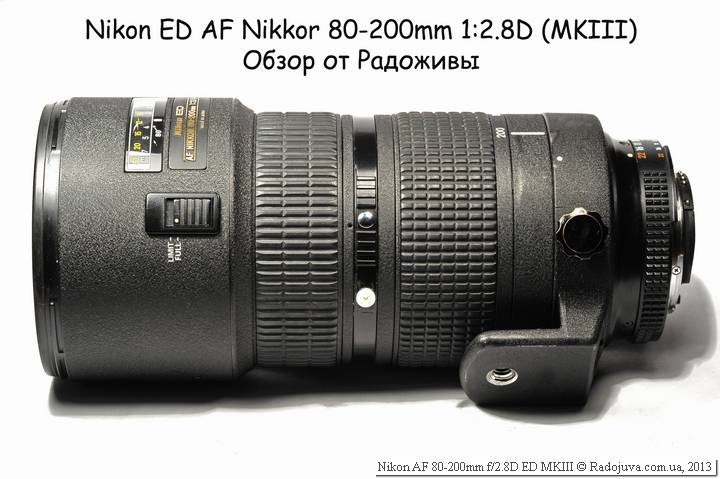
Nikon ED AF Nikkor 80-200mm 1: 2.8D MKIII review
TTX Nikon ED AF Nikkor 80-200mm 1: 2.8D (MKIII)
Focal length: 80-200mm, 2.5X zoom
Diaphragm: F / 2.8-f / 22
Number of aperture blades: 9 pieces
The weight: 1.3kg
Optical design: 16 elements in 11 groups, with 3 ED elements and DIH enlightenment
MDF: 1.5m (1: 5.9 magnification), the lens has a system CRC
Front Filter Diameter: 77 mm
Optically, the third version of the Nikon AF 80-200 / 2.8 lens is no different from the first two versions of MKI and MKII.
A complete and accurate list of all Nikkon Nikkor class 70(80)-(180)200/2.8 autofocus professional lenses:
- Nikon ED AF Nikkor 80-200mm 1: 2.8 (MKI) - November 1987 to September 1992, 16 elements in 11 groups (with 3 ED elements)
- Nikon ED AF Nikkor 80-200mm 1: 2.8D (MKII) - from September 1992 to 1997, 16 elements in 11 groups (with 3 ED elements)
- Nikon ED AF Nikkor 80-200mm 1: 2.8D (MKIII) - January 1997 to present, 16 elements in 11 groups (with 3 ED elements)
- Nikon ED AF-S Nikkor 80-200mm 1: 2.8D Silent Wave Motor (MKIV, AF-S) - from December 1998 to 2003, 18 elements in 14 groups (with 5 ED elements). There are two colors: black and gray.
- Nikon ED AF-S VR-Nikkor 70-200mm 1: 2.8G Vibration Reduction SWM IF (MKV, VRI) from February 2003 to January 2009, 21 elements in 15 groups (with 5 ED elements). There are two colors: black and gray.
- Nikon AF-S Nikkor 70-200mm 1: 2.8GII ED N VR Nano Crystal Coat SWM IF (MKVI, VRII) - July 2009 to present, 21 elements in 16 groups (with 7 ED elements).
- Nikon AF-S Nikkor 70-200mm 1: 2.8E FL ED N VR Nano Crystal Coat (MKVII, E) - from October 2016 to the present, 22 elements in 18 groups (6 ED, 1 FL, 1 HRI element). There is a rare subversion Nikon AF-S Nikkor 70-200mm 1: 2.8E FL ED N VR Nano Crystal Coat Nikon 100th Anniversary (100th Anniversary) - April 2017 to present, features a metallic gray finish with the Nikon 100th Anniversary logo).
- Nikon Nikkor Z 70-200mm 1: 2.8 VR S (MK VIII, Z, S-series) - from January 2020 to the present day. Nikon Z mirrorless version, 21 elements in 18 groups (6 ED, 2 ASP, 1 FL, 1 SR)
- Nikon Nikkor Z 70-180mm 1: 2.8 (MK IX,Z) - from June 2023 to the present day. Version for Nikon Z mirrorless cameras, 19 elements in 14 groups (5 ED, 3 ASP, 1 SUPER ED), diagram from Tamron 70-180mm F / 2.8 Di III VXD Model A056
Old versions Nikon ED 80-200mm f / 2.8D AF Nikkor MKII and MKI are basically different from the Nikon ED 80-200mm f / 2.8D AF Nikkor MKIII using the zoom method and type of enlightenment. The first two versions are often called 'single-ring', since one ring on the lens is responsible for zooming and focusing, and the zoom itself is performed using the piston method. The MKIII version is called 'two roundabout', since there are already two rings on the lens, the first is responsible for zooming, and the second for focusing, while the lens has a classic modern zoom method. All three versions of MKI, II, III have the same optical design, so the image quality of these lenses is quite similar to each other. There are even rumors that the first versions of MKI, MKII are even sharper after the third, I don't believe in that.
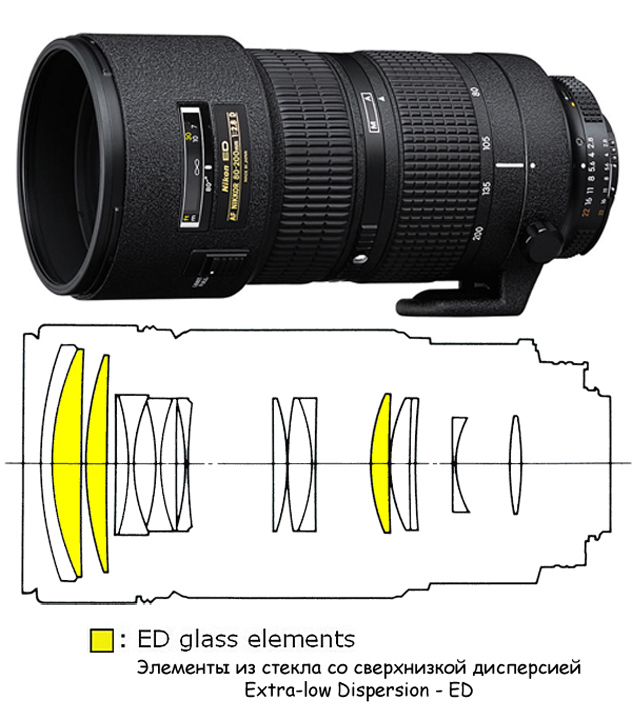
Optical design Nikon ED 80-200mm f / 2.8D AF Nikkor (MKIII)
An interesting point is that until now (at the beginning of 2013) only 2 versions of the lens of the 70 (80) -200 / 2.8 class are produced - this is a nanocrystalline Nikon ED 70-200mm f / 2.8GII AF-S VR N Nikkor (IF) and this old Nikon ED 80-200mm f / 2.8D AF Nikkor (MKIII). The MK3 version has been very, very successful.
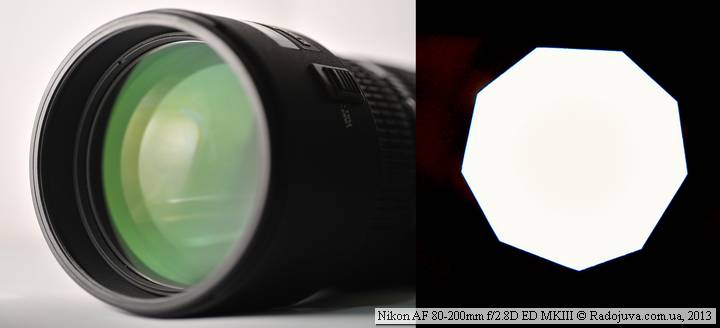
Lens enlightenment Nikon ED AF review Nikkor 80-200mm 1: 2.8D MKIII and aperture view
Nikon AF 80-200mm f / 2.8D ED MKIII made in japanhave been producing the lens since 1996. The build quality is at a very high level, almost the entire lens barrel is made of metal alloy. The zoom and focus rings are rubberized. The lens itself is quite heavy for use on amateur cameras, as it weighs much more than the amateur camera itself. But the appearance of the lens is very 'serious'. The lens uses 'professional' 77 mm filters. On my Nikon D700 sits and looks very nice. Managing the lens is very convenient.
Focusing
Lens does not have internal focus. When focusing, the front lens rides and rotates freely in the lens barrel, but the trunk of the lens does not extendas the lenses are inside the frame. There will be no problems with using filters. Also, while zooming and focusing, the rear lens remains stationary, which reduces the 'vacuum cleaner' effect.
The lens has focus stop. The limiter can switch the lens to one of the modes Full / limit. In 'Full' mode, the lens can focus from infinity to 1.5m. In 'Limit' mode, the lens can focus either from infinity to 2.8m, or from 2.8m to 1.5m. Of course, the lens has a focus scale in meters and feet, as well as an infrared shift indicator for 80mm.
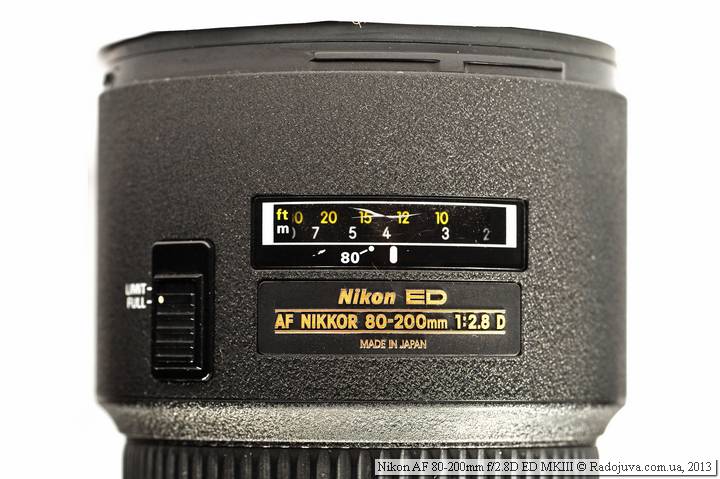
My shabby copy of Nikon 80-200 2.8 MK3
There is a switch on the lens focus mode 'M / A'. In M mode, only manual focus is available. The manual focus ring rotates on 90 degrees in 'Full' mode, and 60 degrees in 'Limit' mode. Manual focusing is quite easy and pleasant. In focus mode 'A', only auto focus is available and the focus ring remains locked. The focus mode switch has a lock button. This button is very inconvenient to use, and the switch itself, which is made in the form of a ring, is inconvenient enough to rotate to switch the focusing mode. The focus mode switch is the only thing I didn't like about this lens.
The autofocus of the lens is fast. When using the 'Limit' mode, little time is spent running the lenses from infinity to the limiting value. In the 'Full' mode, the lenses take much longer to run. Of course, due to the camera's screwdriver being used to focus, the lens emits quite loud noise with auto focus.
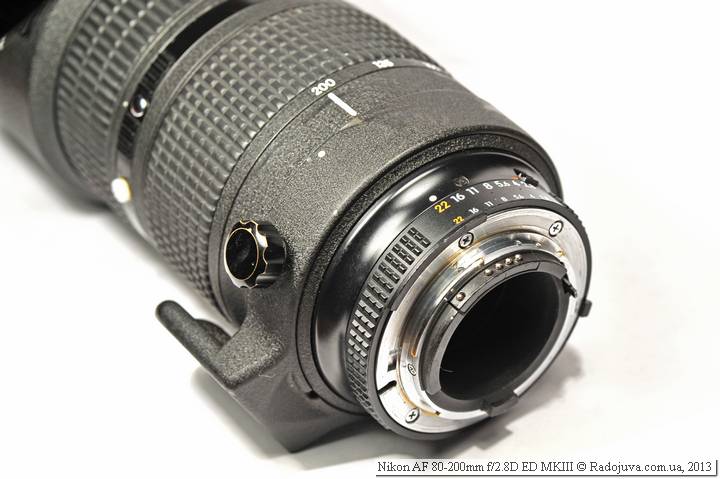
View of the Nikon ED AF Nikkor 80-200mm 1: 2.8D MKIII lens from the bayonet side
It's important: auto focus with this lens is available only when using him on cameras with built-in motor focusing.
Exact list Nikon DSLR cameras with a built-in focus motor, on which this lens will focus automatically:
- D1, D1h, D1x, D2x, D2xs, D2h, D2hs
- D3, D3x, D3s, D4, D4s, D5, D6
- Df
- D50, D70, D70s, D80, D90
- D7000, D7100, D7200,D7500
- D100, D200, D300, D300s,D500
- D600, D610, D750, D780
- D700, D800,D800E, D810, D810a, D850
- Fujifilm FinePix S1 Pro, S2 Pro, S3 ProS3 Pro UVIR, S5 ProIS Pro
- Kodak DCS PRO 14n, DCS Pro SLR/n
Exact list Nikon DSLR cameras without a built-in focus motor, on which this lens will not focus automatically:
Only auto focus and sound confirmation of focus will not work with these cameras, all other important functions, such as automatic exposure metering and automatic iris control, will work well.
You will find a lot of useful information on the types of cameras and lenses Nikon here.
Important: the lens has an aperture control ring. In order for the lens to start working normally on modern CZKs, you need to set the f / 22 value on the lens and snap a special switch near the aperture control ring. After such a manipulation, the aperture can be controlled from the camera, in more detail in the section on Non-G type lens.
The lens has tripod socket with foot. The socket cannot be removed. The socket foot can rotate around the lens and be fixed using a special clip.
Sample photos on Nikon AF 80-200mm f / 2.8D ED MKIII and full frame
All photo without processing. All photos in the gallery below were shot with a Nikon ED 80-200mm f / 2.8D AF Nikkor (MKIII) lens and camera Nikon D700, RAW, NL image management mode, converted to JPEG using VinewNX 2 with automatic detection BB (Calculate Automaticaly), reduced size to 3MP and imprinted data from EXIF.
Sample photos on Nikon AF 80-200mm f / 2.8D ED MKIII and cropped camera
All photo without processing. All photos in the gallery below were shot with a Nikon ED 80-200mm f / 2.8D AF Nikkor (MKIII) lens and camera Nikon D80, RAW, PO picture management mode, converted to JPEG using VinewNX 2 with automatic detection BB (Calculate Automaticaly), reduced size to 3MP and imprinted data from EXIF.
When using the lens on Nikon DX cameras EGF will be 120-300mm. Even on crop, this lens remains just a gorgeous tool in the hands of the photographer. The lens is well suited for portraiture, wedding photography, for wildlife photography, sports.
Personal experience
There are no significant complaints to the Nikon AF 80-200mm f / 2.8D ED MKIII, it is really a worthwhile lens, a good budget option to replace the expensive 70-200 / 2.8GII N VR. Many people write that the disadvantage of the lens is its weight, for me it is rather a virtue. Great weight helps take pictures with hand without grease. Of course, on F / 2.8 it’s not as sharp as a razor, but picture quality is really high. The lens may still use a lens hood HB-7, with a lens hood, the lens looks generally irresistible. Nikon 80-200 F2.8 MK3 can be considered one of the three lenses of a professional photographer, who should be in a case.
You can see the prices for the lens in popular stores. at this link, or in the price block below:
Comments on this post do not require registration. Anyone can leave a comment. Many different photographic equipment can be found on AliExpress.
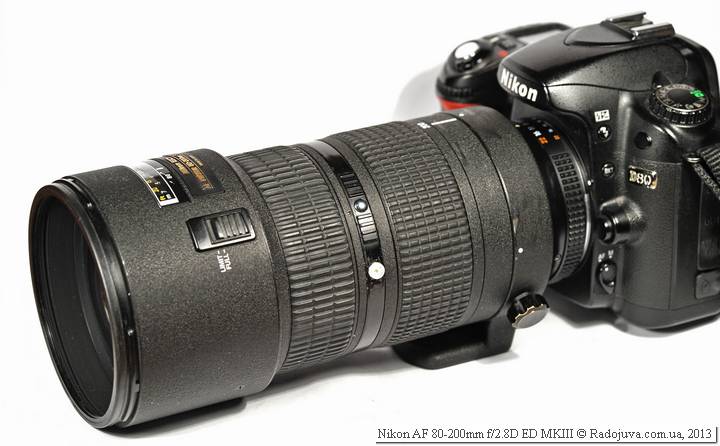
Lens view Overview Nikon ED AF Nikkor 80-200mm 1: 2.8D MKIII on Nikon D80
Conclusions:
Nikon ED AF Nikkor 80-200mm 1: 2.8D (MKIII) - great professional lens. Good value for money. I recommend.
Material prepared Arkady Shapoval. Training/Consultations | Youtube | Facebook | Instagram | Twitter | Telegram
































The lens is not very, the model, as always on top, well, the photographer!
Why is the lens not so?
Arkady, what is the piston zoom method? And on IR questions - it turns out that in this mode the focus plane is shifted? Why is the label only for 80, how to focus on 200?
This is such a method of changing the focal length, called piston (it is also called 'trombone'). In order to change the focal length, you just need to pull the 'piston' towards or away from you, and not rotate the zoom ring. IR mark is needed for shooting in the infrared spectrum.
Because you are spoiled, your users are in your reviews more interesting in everything!
well, that’s another matter :)
It's amazing sometimes how flattened by a meteorite are ...
Arkady, you are doing a VERY necessary thing, thank you!
Video review of the lens is not 80-200, but 17-55. 80-200 is a super weapon, but not cheap, so only for pros and ff!
Arkady, hello! thanks for the review of this glass. As always, it is interesting to read your directory-directory "Nikonist". and I got bogged down with such glass: I screwed it on my d300s and neither here nor there, in general I did not take a single picture, it turns out I had to jam the aperture at 22, set the minimum and maximum apertures on the camera for "hand glasses", in general dried out. but so real on the camera sits on business, made in jyapan in one word! must be taken while they are being sold. I also mentioned in the review “one of the three glasses that should lie in a mobile bag-darkroom”)), well, what are the other two ?? I have 24-70 as the main one, and an old manual half, well, when I don't want to carry a lot of weight, so to speak, for “sketches”. in general, ATP, with SW., DV
Usually they mean a bunch of 14-24 (17-35), 24-70 (28-70), 70-200 (80-200)
A very successful bunch of 20-35 / 2,8, 35-70 / 2,8 and 80-200 / 2,8 IMHO
For about six months I’ve been eyeing this glass, it’s a very tasty value for money. Thanks for the review and especially for the photos!
A week ago I bought this lens. Compared a lot. Quality is at the level of both constructive and result.
In a live magazine I saw a proposal for the sale of this lens with a 4-year term of use for 20.000 rubles. Is it worth it or?
Check for back / front focus and take! Price is the norm! If everything is ok-take! Do not wish.
I have been looking for a long time a good copy for the price norms, but alas.
A new http://www.sotmarket.ru/product/nikon_80_200mm_f_2_8d_ed_af_s_zoom_nikkor.html that's it.
Great review! The pigeon is gorgeous. =)
What you like about your reviews is concise, accessible, sensible! Of course, the glass is gorgeous, but for such focal stubs it will be very useful because a tripod is not always convenient to use, especially for dynamic scenes! The new Nikon 70-200 f / 2/8, of course, is the leader here, but dear infection! I wonder your opinion if you want to save money and get decent quality, what to prefer the 80-200 that you described, or Sigma AF 70-200mm f / 2.8 APO EX DG OS HSM Nikon F or Tamron SP AF 70-200mm f / 2.8 Di VC USD Nikon F, considering that they have a stab.?
If there is an opportunity to test Sigma and Tamron, I will describe whether it is worth it.
tamron is very stupid with a lack of lighting
can be considered one of the three lenses of a professional photographer that should be in a wardrobe trunk \\ - but which two? fifty dollars 1.4 and 85? or 24-70 and fish?
I already answered this question: Usually they mean a bunch of 14-24 (17-35), 24-70 (28-70), 70-200 (80-200)
And in this case, fixes still have a place in the office of a professional photographer?
This is just an opinion.
Arkady, thanks for the review! very interesting and informative! but the comparison with Sigma and Tamron (mentioned above) is definitely not enough, since glass is in the same price group ...
Cool review ... Please advise, the store has the same lens, but only you have MKIII at the end and here the name is Nikon AF-80-200mm-f-2-8D-ED without MKIII This is the same. ???? http://www.cyfrovychok.ua/Nikon-AF-80-200mm-f-2-8D-ED.html
This is him. There are no MKs in the name on the lens, due to the fact that there are many versions of lenses, users, including myself, are adding MKs to know what it is about.
This review was the final straw ...
I will take under D800
I cook up a report for the newspaper on the 70-300VR,
Yes, and 24-120 / 4VR is always at hand.
but "the soul of the bazha is holy!"
The lens is really good, not expensive relative to the “70-200” it draws just fabulous, besides, it is not as heavy as its “big brother”.
I doubted for a long time before buying 70-200 or 80-200, but in the latter there is no stabilizer and without it it is hard to work in a commercial shoot, so I took 70-200.
Thank you Arkady for the review, as always, everything is easy and pleasant to read.
Good afternoon Arkady.
How do you think Nikon 70-210mm f / 4 AF https://radojuva.com.ua/2011/12/nikon-70-210-mm-f-4-af-review/ greatly inferior in picture quality to the Nikon AF 80-200mm f / 2.8D ED MKIII.
Good afternoon!
I am looking for a telezoom for shooting wildlife in nature - how do you rate this lens for shooting moving objects - birds, small animals (squirrels, chipmunks, beavers, hares, etc.) I'm already tired of choosing, but I don't want dark ones, it's difficult with them in the forest. This is the most inexpensive of Nikon's bright AFs. Yes, the camera is D7000.
http://dimch.ru/AF-80-200-2.8_821325.html
What a razor sharpness! And I can’t achieve sharpness with this lens on the D200, even on covered apertures. Could it be the carcass?
Good afternoon, Arkady!
Tell me, please, how does this lens manifest itself in studio shooting?
Thank you for your reply!
Good day! Tell me, is the HB-29 lens hood not suitable for this glass? Are there any other petal analogues?
Today bought, happy as an elephant
Sharpness at 2.8f is not very good, and 3.2 is already better
I had 28-300, I barely got rid of it, the picture quality is like heaven
I would have bought 80-200d for a long time, I just didn’t know about it
I strongly advise!
Sergey, what carcass are you using? I have a D200 and on f / 2.8 there is also no sharpness. And if the FR 200mm still stands, then in general you can forget about the sharpness. More or less sharp shots start from f / 3.2 and FR 170.
I bought 22,06,13 on player.ru for 31000 + a cool tube goes to it! I advise everyone!